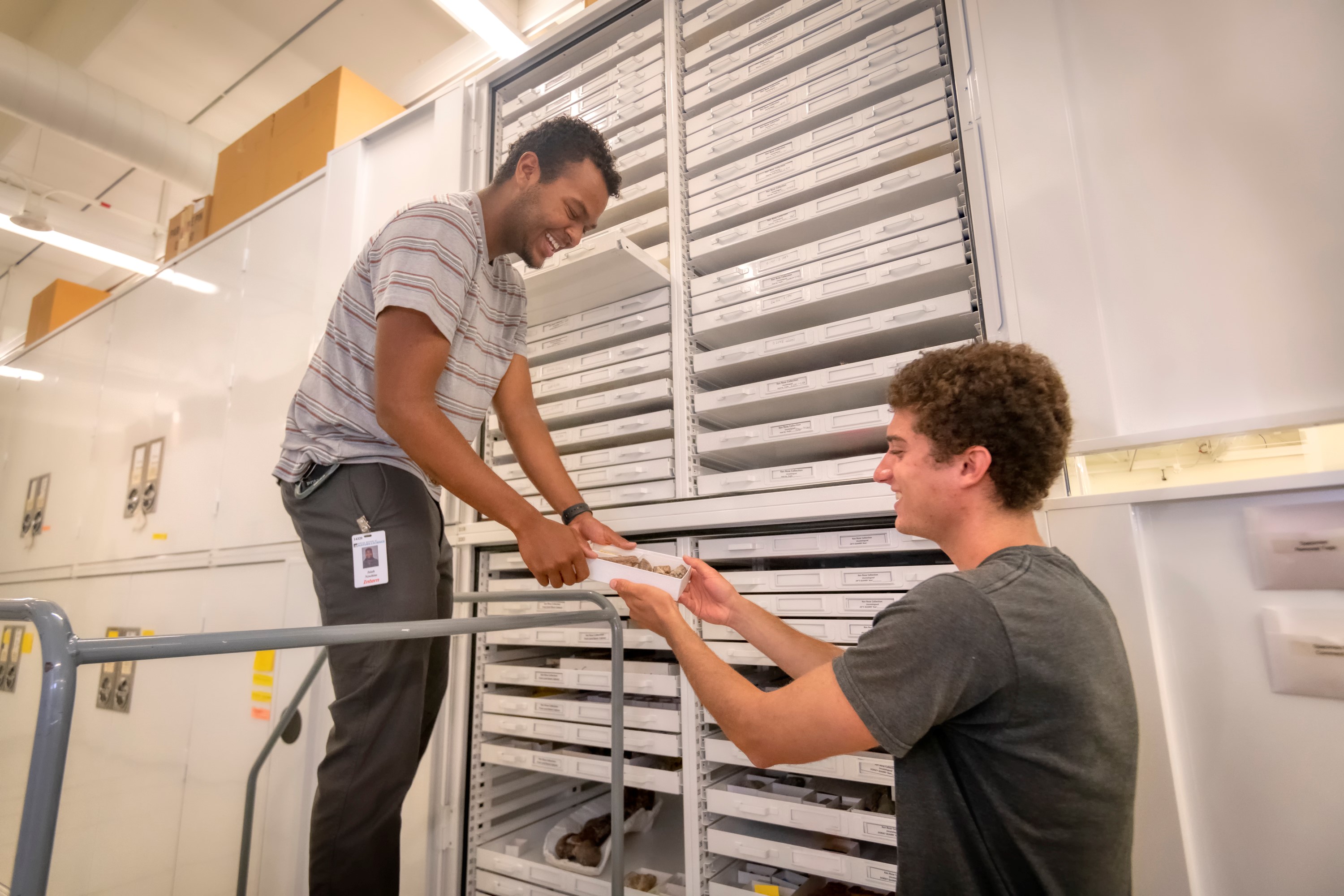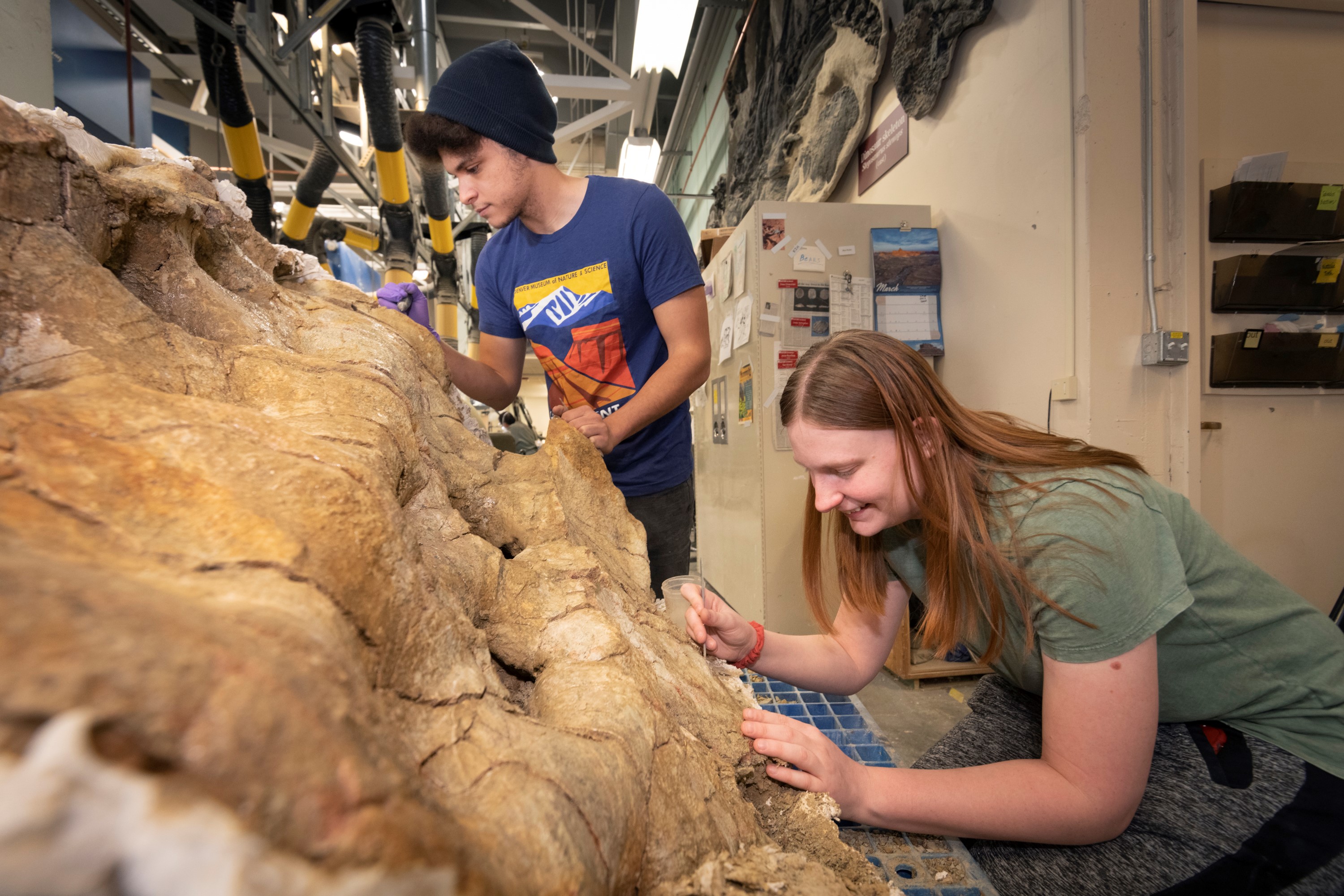

Interns Isaiah Newbins and Luke Friedman organizing collections cabinets, 2022. (Photo/Rick Wicker)
Maddie and Joseph are two of the many interns training in a variety of scientific disciplines at the Denver Museum of Nature & Science. Internships are temporary positions that allow students, recent graduates and early-career scientists to build specialized skills while exposing them to potential career paths in science and specimen-based research. While interns become proficient in a variety of techniques and interact with many scientists, their focus depends on the department they work in. In the Earth Sciences fossil preparation lab, which is home base for Maddie and Joseph, interns work alongside an experienced team of volunteers and staff, where they learn modern techniques for safely removing fossils from stone and stabilizing them for long-term storage, exhibition and research. Their counterparts in the Digital Research Lab work with CT scans of fossils visualizing areas that can’t be seen externally, such as inner ear bones and braincases.
After preparation, the fossils head 50 feet underground to collections, an ever-evolving library of fossils. There, you can also find interns sorting, identifying and cataloging specimens by position in geologic time and on the tree of life. Other interns in Earth Sciences focus on research projects. For example, they may be working with curators and digging through geologic literature to create maps of prehistoric Earth through time, or you may find them mapping the skull bones of ancient reptiles. The Earth Sciences program alone has hosted nearly 200 interns since 2017, and other departments help interns cultivate their own sets of specialized skills working with zoological specimens, archaeological artifacts and data collected from outer space. Toward the end of their time at the Museum – typically three to six months – each group of young scientists will bring their educational journey full circle by helping to train the next incoming intern cohort.
Beyond their daily responsibilities, interns plug into the myriad other opportunities that make the work unique. You can chat with an Earth Sciences intern eager to share their hard work and new knowledge at a pop-up "Science on the Spot" event, where they can be found with tables of freshly cleaned and cataloged fossils on display for visitors. Interns are encouraged to pursue research side projects and connect with mentors in the subspecialties that interest them. Summer interns in Earth Sciences may take advantage of fieldwork season, learning techniques for discovering and digging up fossils across the American West. This includes reading the rock and navigating the backcountry, mapping quarries, managing camp dynamics and dealing with every monkey wrench that Mother Nature throws into a carefully planned field season!
Though we often refer to the internship program, this title doesn't capture the patchwork of partnerships and funding that enables interns to spend time cultivating their skills. Some internships are grant-funded to support specific projects. In Maddie and Joseph’s case, the U.S. Forest Service funds their work on fossils from Comanche National Grasslands. Other interns have been supported by individual donors or private foundations such as the David B. Jones Foundation. Earth Sciences has also collaborated with universities across Colorado and beyond that provide students class credit or a stipend to intern at our Museum.

Interns Maddie Price and Joseph Hopkins preparing the hips of a long-necked dinosaur, 2023. (Credit/Rick Wicker)
Intern supervisors, working closely with the Volunteer Engagement Department, find applicants who have lots to gain from an internship as well as impressive potential. Though the number of interns hosted has grown immensely over the past several years, the future of our hodgepodge program is inherently uncertain. Looking ahead, we hope to find a way to create a more stable internship program, ensuring a resource where young professionals from all walks of life can engage in hands-on science.
The variety of authentic experiences for interns is matched only by the array of opportunities they pursue afterward. Interns in recent years have gone on to prestigious graduate programs around the country and the globe. As a result of training and connections built here, many now work as lab technicians, researchers or collections managers at government institutions, museums and universities. Still, others attain Earth Science careers in contract paleontology or consulting in industry. A few interns have even returned to work here, including preparators Sadie Sherman, Evan Tamez-Galvan and Salvador Bastien; digital preparators Eldon Panigot and Franklin Duffy; and curator of paleobotany Gussie Maccracken.
By the time this Catalyst magazine prints this Summer, Maddie and Joseph will have moved on from their internship to the next adventure and will be dearly missed by all in Earth Sciences. Maddie is off to finish her master's degree in museum science and Joseph plans to spend his summer exploring the stratigraphy of the Uinta Basin. Regardless of where these two find their long-term passions, they head into the future with fresh skill sets, a new network of professional scientists and absolutely no idea how their mentors take their coffee.

Intern Makayla Hutchinson showing off her preparation work at a Science on the Spot event, 2021. (Credit/Rick Wicker)
